“Filtering solid Gabor noise” by Lagae and Drettakis
Conference:
Type(s):
Title:
- Filtering solid Gabor noise
Presenter(s)/Author(s):
Abstract:
Solid noise is a fundamental tool in computer graphics. Surprisingly, no existing noise function supports both high-quality antialiasing and continuity across sharp edges. In this paper we show that a slicing approach is required to preserve continuity across sharp edges, and we present a new noise function that supports anisotropic filtering of sliced solid noise. This is made possible by individually filtering the slices of Gabor kernels, which requires the proper treatment of phase. This in turn leads to the introduction of the phase-augmented Gabor kernel and random-phase Gabor noise, our new noise function. We demonstrate that our new noise function supports both high-quality anti-aliasing and continuity across sharp edges, as well as anisotropy.
References:
1. Bracewell, R. N. 1999. The Fourier Transform and its Applications, 3rd ed. McGraw-Hill.Google Scholar
2. Cook, R. L., and DeRose, T. 2005. Wavelet noise. ACM Trans. Graph. 24, 3, 803–811. Google ScholarDigital Library
3. Goldberg, A., Zwicker, M., and Durand, F. 2008. Anisotropic noise. ACM Trans. Graph. 27, 3, 54:1–54:8. Google ScholarDigital Library
4. Hart, J. C., Carr, N., Kameya, M., Tibbitts, S. A., and Coleman, T. J. 1999. Antialiased parameterized solid texturing simplified for consumer-level hardware implementation. In Proc. Graph. hardware, 45–53. Google Scholar
5. Heckbert, P. S. 1989. Fundamentals of Texture Mapping and Image Warping. Master’s thesis.Google Scholar
6. Lagae, A., Lefebvre, S., Drettakis, G., and Dutré, P. 2009. Procedural noise using sparse Gabor convolution. ACM Trans. Graph. 28, 3, 54:1–54:10. Google ScholarDigital Library
7. Lagae, A., Lefebvre, S., Cook, R., DeRose, T., Drettakis, G., Ebert, D. S., Lewis, J. P., Perlin, K., and Zwicker, M. 2010a. A survey of procedural noise functions. Comp. Graph. Forum 29, 8, 2579–2600.Google ScholarCross Ref
8. Lagae, A., Vangorp, P., Lenaerts, T., and Dutré, P. 2010b. Procedural isotropic stochastic textures by example. Computers & Graphics 34, 4, 312–321. Google ScholarDigital Library
9. Lagae, A., Lefebvre, S., and Dutré, P. 2011. Improving Gabor noise. IEEE Trans. Vis. Comp. Graph.. to appear. Google Scholar
10. Lewis, J. P. 1989. Algorithms for solid noise synthesis. In Computer Graphics (Proc. ACM SIGGRAPH 89), vol. 23, 263–270. Google Scholar
11. Norton, A., Rockwood, A. P., and Skolmoski, P. T. 1982. Clamping: A method of antialiasing textured surfaces by bandwidth limiting in object space. In Comp. Graph. (Proc. ACM SIGGRAPH 82), vol. 16, 1–8. Google ScholarCross Ref
12. Papoulis, A., and Pillai, U. 2002. Probability, Random Variables and Stochastic Processes, 4rd ed. McGraw-Hill.Google Scholar
13. Peachy, D. R. 1985. Solid texturing of complex surfaces. In Comp. Graph. (Proc. ACM SIGGRAPH 85), vol. 19, 279–286. Google ScholarDigital Library
14. Perlin, K. 1985. An image synthesizer. In Comp. Graph. (Proc. ACM SIGGRAPH 85), vol. 19, 287–296. Google ScholarDigital Library




